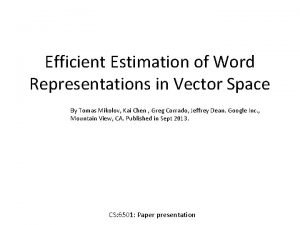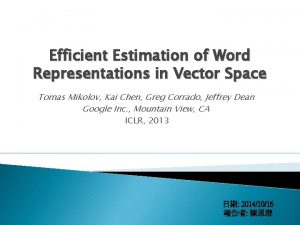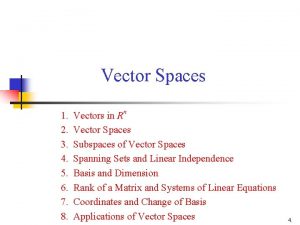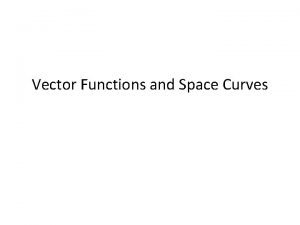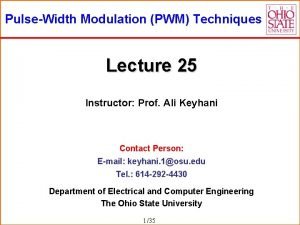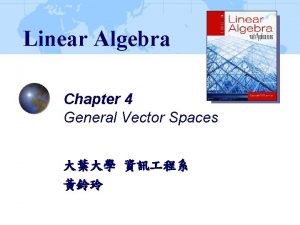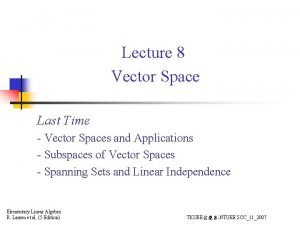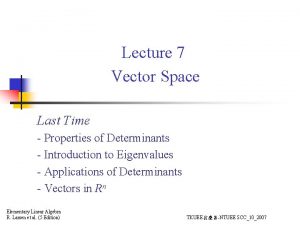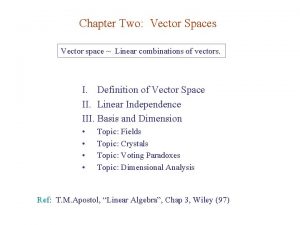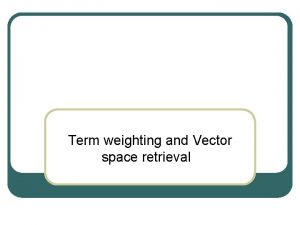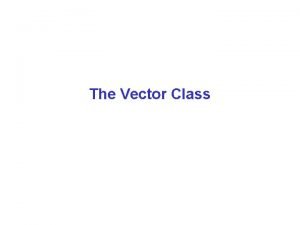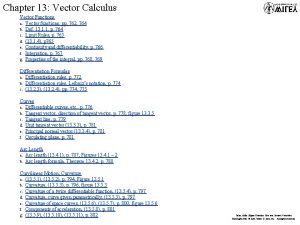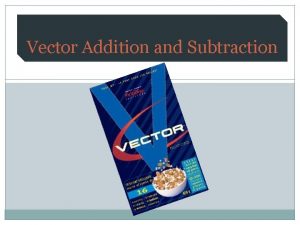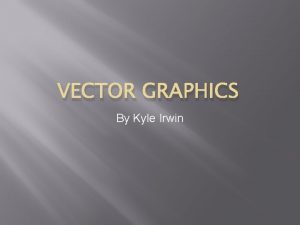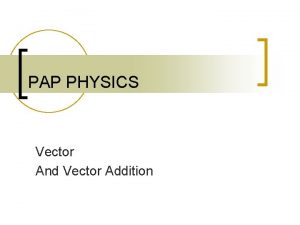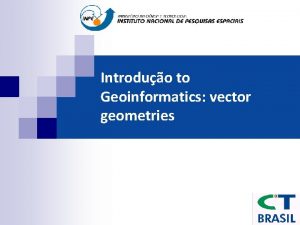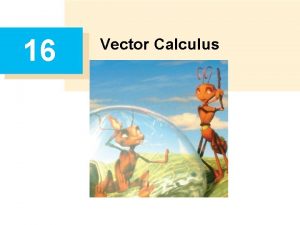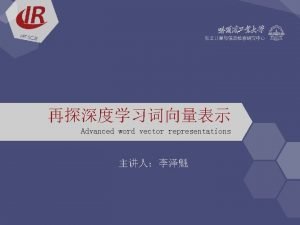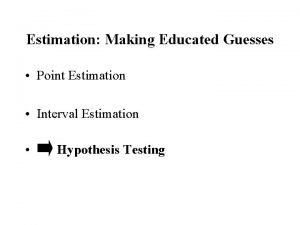Efficient Estimation of Word Representations in Vector Space


















- Slides: 18

Efficient Estimation of Word Representations in Vector Space Tomas Mikolov, Kai Chen, Greg Corrado, Jeffrey Dean Google Inc. , Mountain View, CA ICLR, 2013 日期: 2014/10/16 報告者: 陳思澄

Outline � Introduction � New Log-linear Models Continuous Bag-of-Words Model (CBOW) Continuous Skip-gram Model � Results � Conclusion

Introduction � The main goal of this paper is to introduce techniques that can be used for learning high-quality word vectors from huge data sets with billions of words, and with millions of words in the vocabulary. � We use recently proposed techniques for measuring the quality of the resulting vector representations, with the expectation that not only will similar words tend to be close to each other, but that words can have multiple degrees of similarity. � Somewhat surprisingly, it was found that similarity of word representations goes beyond simple syntactic regularities.

Introduction � Example : vector(“King”) - vector (“Man”) + vector(“Woman”) results in a vector that is closest to the vector representation of the word Queen. � We design a new comprehensive test set for measuring both syntactic and semantic regularities , and show that many such regularities can be learned with high accuracy. � Moreover, we discuss how training time and accuracy depends on the dimensionality of the word vectors and on the amount of the training data.

New Log-linear Models � We propose two new model architectures for learning distributed representations of words that try to minimize computational complexity. � We decided to explore simpler models that might not be able to represent the data as precisely as neural networks, but can possibly be trained on much more data efficiently.

Continuous Bag-of-Words Model (CBOW) � The first proposed architecture is similar to the feedforward NNLM, where the non-linear hidden layer is removed and the projection layer is shared for all words ; thus, all words get projected into the same position.

Continuous Skip-gram Model The second architecture is similar to CBOW, but instead of predicting the current word based on the context. � We found that increasing the range improves quality of the resulting word vectors, but it also increases the computational complexity. � P(wt-2, wt-1 , wt+2 |wt)

Result (1/6) � We follow previous observation that there can be many different types of similarities between words. � We further denote two pairs of words with the same relationship as a question, as we can ask: ”What is the word that is similar to small in the same sense as biggest is similar to big? ” � These questions can be answered by performing simple algebraic operations with the vector representation of words. vector X = vector("biggest") -vector("big")+vector("small"). � Then, we search in the vector space for the word closest to X measured by cosine distance, and use it as the answer to the question (we discard the input question words during this search). � When the word vectors are well trained, it is possible to find the correct answer (word smallest) using this method.

Result (2/6) � Finally, we found that when we train high dimensional word vectors on a large amount of data, the resulting vectors can be used to answer very subtle semantic relationships between words, such as a city and the country it belongs to, e. g. France is to Paris as Germany is to Berlin. � Word vectors with such semantic relationships could be used to improve many existing NLP applications, such as machine translation, information retrieval and question answering systems, and may enable other future applications yet to be invented.

Result (3/6) 8869 semantic , 10675 syntactic questions

Result (4/6) Corpus: Word vector: Google News (6 B tokens) Vocabulary size: 30 k most frequent words Corpus: LDC (320 M words , 82 k vocabulary)

Result (5/6)

Result (6/6)

Conclusion In this paper we studied the quality of vector representations of words derived by various models on a collection of syntactic and semantic language tasks. � We observed that it is possible to train high quality word vectors using very simple model architectures, compared to the popular neural network models (both feedforward and recurrent). � Because of the much lower computational complexity, it is possible to compute very accurate high dimensional word vectors from a much larger data set. � Our ongoing work shows that the word vectors can be successfully applied to automatic extension of facts in Knowledge Bases, and also for verification of correctness of existing facts. � In the future, it would be also interesting to compare our techniques to Latent Relational Analysis and others. �

Word 2 vec Tool � 網址: https: //code. google. com/p/word 2 vec/

Word 2 vec 語料: 台達電EDU 000~EDU 0003會議內容


RNN實驗結果 Word. Num =5 Edu 0000 Edu 0001 Edu 0002 Edu 0003 Baseline 86. 38 82. 0 80. 51 75. 83 89. 04 83. 69 91. 22 87. 92 Rnn+Ngram � � RNN (PPL) Ngram (PPL) edu 0000 33. 3438 36. 1975 edu 0001 39. 6715 81. 969 edu 0002 33. 5458 44. 613 edu 0003 34. 0591 41. 2404 訓練階段語料: MATBN+ Delta 語言模型。 (約6000句,檔案大小 1481 KB) 發展集語料: edu 0000~edu 0003. 測試集語料: edu 0000 的 Nbest ~ edu 0003 的 Nbest. 實驗設定: Hidden_size : 400 Class_size : 200
 Efficient estimation of word representations invector space
Efficient estimation of word representations invector space Efficient estimation of word representations
Efficient estimation of word representations Productively efficient vs allocatively efficient
Productively efficient vs allocatively efficient Productively efficient vs allocatively efficient
Productively efficient vs allocatively efficient C b a d
C b a d Productively efficient vs allocatively efficient
Productively efficient vs allocatively efficient Productively efficient vs allocatively efficient
Productively efficient vs allocatively efficient Given that a vector is the directed line segment
Given that a vector is the directed line segment Vector unitario formula
Vector unitario formula Vector resolution
Vector resolution Define the position vector
Define the position vector Round 753 to the nearest hundred
Round 753 to the nearest hundred Vectors in rn
Vectors in rn Vector functions and space curves
Vector functions and space curves Space vector pwm
Space vector pwm Subspace in vector space
Subspace in vector space Condition for linearly independent vectors
Condition for linearly independent vectors Vector space properties
Vector space properties Linear span of vectors
Linear span of vectors
